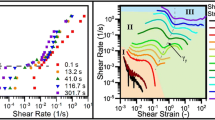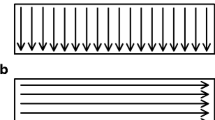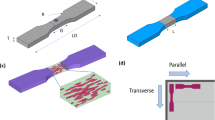Abstract
An ultra-violet (UV) curable ink jet 3D printed material was characterized by an inverse finite element modeling (IFEM) technique employing a nonlinear viscoelastic–viscoplastic (NVEVP) material constitutive model; this methodology was compared directly with nanoindentation tests. The printed UV cured ink jet material properties were found to be z-depth dependent owing to the sequential layer-by-layer deposition approach. With further post-UV curing, the z-depth dependence was weakened but properties at all depths were influenced by the duration of UV exposure, indicating that none of the materials within the samples had reached full cure during the 3D printing process. Effects due to the proximity of an indentation to the 3D printed material material-sample fixing interface, and the different mounting material, in a test sample were examined by direct 3D finite element simulation and shown to be insignificant for experiments performed at a distance greater than 20 µm from the interface.















Similar content being viewed by others
Change history
01 July 2017
An Erratum to this paper has been published: https://doi.org/10.1557/jmr.2017.181
References
J-P. Kruth, M.C. Leu, and T. Nakagawa: Progress in additive manufacturing and rapid prototyping. CIRP Ann. 47, 525–540 (1998).
I. Gibson, D. Rosen, and B. Stucker: Additive Manufacturing Technologies 3D Printing, Rapid Prototyping, and Direct Digital Manufacturing (Springer, New York, 2010); pp. 63–203.
L.P. Hue: Progress and trends in ink-jet printing technology. J. Imaging Sci. Technol. 42(1), 49–62 (1998).
S. Vafaei, C. Tuck, R. Wildman, and I. Ashcroft: Spreading of the nanofluid triple line in ink jet printed electronics tracks. Addit. Manuf. 11, 77–84 (2016).
D.H. Gunasekera, S. Kuek, D. Hasanai, Y. He, C. Tuck, A.K. Croft, and R.D. Wildman: Three dimensional ink-jet printing of biomaterials using ionic liquids and co-solvents. Faraday Discuss. 190, 509 (2016).
Y. He, C.J. Tuck, E. Prina, S. Kilsby, S.D.R. Christie, S. Edmondson, R.J.M. Hague, F.R.A. Rose, and R.D. Wildman: A new photocrosslinkable polycaprolactone-based ink for three-dimensional inkjet printing. J. Biomed. Mater. Res., Part B 00B, 1–13 (2016).
F. Zhang, C. Tuck, R. Hague, Y. He, E. Saleh, Y. Li, C. Sturgess, and R. Wildman: Inkjet printing of polyimide insulators for the 3D printing of dielectric materials for microelectronic applications. J. Appl. Polym. Sci. 133, 43361(1–11) (2016).
Y. He, R.D. Wildman, C.J. Tuck, S.D.R. Christie, and S. Edmonson: An investigation of the behavior of solvent based polycaprolactone ink for material jetting. Sci. Rep. 6, 20852 (2016).
M. Domingos, F. Intranuovo, T. Russo, R. De Santis, A. Gloria, L. Ambrosio, J. Ciurana, and P. Bartolo: The first systematic analysis of 3D rapid prototyped poly(ε-caprolactone) scaffolds manufactured through BioCell printing: The effect of pore size and geometry on compressive mechanical behaviour and in vitro hMSC viability. Biofabrication 5(4), 045004(13 pp) (2013).
T. Patrício, M. Domingos, A. Gloria, U. D’Amora, J.F. Coelho, and P.J. Bártolo: Fabrication and characterisation of PCL and PCL/PLA scaffolds for tissue engineering. Rapid Prototyping J. 20(2), 145–156 (2014).
L.R. Hart, S. Li, C. Sturgess, R. Wildman, J.R. Jones, and W. Hayes: 3D printing of biocompatible supramolecular polymers and their composites. ACS Appl. Mater. Interfaces 8, 3115–3122 (2016).
S. Fathi and P.M. Dickens: Challenges in drop-on-drop deposition of reactive molten nylon materials for additive manufacturing. J. Mater. Process. Technol. 213, 84–93 (2013).
R.B. Kulkarni and C.R. Manners: Stereolithographic process of making a three-dimensional object, US6558606 B1, May 6, 2003.
M.P. Lee, G.J.T. Cooper, T. Hinkley, G.M. Gibson, M.J. Padgett, and L. Cronin: Development of a 3D printer using scanning projection stereolithography. Sci. Rep. 5, 9875. (2015).
M.N. Cooke, J.P. Fisher, D. Dean, C. Rimnac, and A.G. Mikos: Use of stereolithography to manufacture critical-sized 3D biodegradable scaffolds for bone ingrowth. J. Biomed. Mater. Res., Part B 64, 65–69 (2003).
P.W. Melchels, J. Feijen, and D.W. Grijpm: A review on stereolithography and its applications in biomedical engineering. Biomaterials 31, 6121–6130 (2010).
M. Dao, N. Chollacoop, K.J. Van Vliet, T.A. Venkatesh, and S. Suresh: Computational modeling of the forward and reverse problems in instrumented sharp indentation. Acta Mater. 49, 3899–3918 (2001).
J. Lin, X.Y. Niu, and X.F. Shu: Reverse analysis for determining the mechanical properties of zeolite ferrierite crystal. J. Nanomater., 2008, 395738 (2008).
C. Hernandez, A. Maranon, I.A. Ashcroft, and J.P. Cases-Rodriguez: An inverse problem for the characterization of dynamic material model parameters from a single SHPB test. Procedia Eng. 10, 1603–1608 (2011).
G. Rauchs and J. Bardon: Identification of elasto-viscoplastic material parameters by indentation testing and combined finite element modeling and numerical optimization. Finite Elem. Anal. Des. 47, 653–667 (2011).
C. Hernandez, A. Maranon, I.A. Ashcroft, and J.P. Casas-Rodriguez: A computational determination of the Cowper-Symonds parameters from a single Taylor test. Appl. Math. Model. 37, 4698–4708 (2013).
M. Hamzah, D. Subit, S. Boruah, J. Forman, J. Crandall, D. Ito, S. Ejima, K. Kamiji, and T. Yasuki: An inverse finite element approach for estimating the fiber orientations in intercostal muscles. Presented at the IRCOBI Conference 2013, IRC-13-88, pp. 722–733.
C.A. Clifford and M.P. Seah: Modeling of nanomechanical nanoindentation measurements using an AFM or nanoindenter for compliant layers on stiffer substrates. Nanotechnology 17, 5283–5292 (2006).
A. Gerday, N. Clement, P. Jacques, T. Pardoen, A. Habaken, and G.K. Nihon: Inverse modeling of nanoindentation tests to identify Ti-555 behavior. Presented at the World Conference on Titanium; Ti-2007 Science and Technology; JIMIC5, 507–510.
J. Wang and T.C. Ovaer: Computational mechanical property determination of viscoelastic/plastic materials from nanoindentation creep test data. J. Mater. Res. 24, 1245–1257 (2009).
P. Zlamal, O. Jirousek, D. Kytyr, and T. Doktor: Indirect determination of material model parameters for single trabecula based on nanoindentation and three-point bending test. Presented at the 18th International Conference, Engineering Mechanics, Svratka, Czech Republic, 2012, pp. 394–395.
M.H. Abyaneh, R.D. Wildman, I.A. Ashcroft, and P.D. Ruiz: A hybrid approach to determining cornea mechanical properties in vivo, using a combination of nano-indentation and inverse finite element analysis. J. Mech. Behav. Biomed. Mater. 27, 239–248 (2013).
X. Chen, I. Ashcroft, R. Wildman, and C. Tuck: An inverse analysis method for the depth profiling and characterisation of 3D printed objects. Proc. R. Soc. A 471, 20150477 (2015).
J.R. Sheats, J.J. Diamond, and J.M. Smitht: Photochemistry in strongly absorbing media. J. Phys. Chem. 92, 4922–4938 (1988).
Y. Liu and M.B. Huglin: Effective crosslinking densities and elastic moduli of some physically crosslinked hydrogels. Polymer 36, 1715–1718 (1995).
Y.V. Milman, А.А. Golubenko, and S.N. Dub: Indentation size effect in nanohardness. Acta Mater. 59, 7480–7487 (2011).
ACKNOWLEDGMENTS
The authors would like to acknowledge the support of University of Nottingham and of the Engineering and Physical Research Council for funding under grant EP/I033335/2, the EPSRC Center for Innovative Manufacturing in Additive Manufacturing.
Author information
Authors and Affiliations
Corresponding author
Rights and permissions
About this article
Cite this article
Chen, X., Ashcroft, I.A., Tuck, C.J. et al. An investigation into the depth and time dependent behavior of UV cured 3D ink jet printed objects. Journal of Materials Research 32, 1407–1420 (2017). https://doi.org/10.1557/jmr.2017.4
Received:
Accepted:
Published:
Issue Date:
DOI: https://doi.org/10.1557/jmr.2017.4




